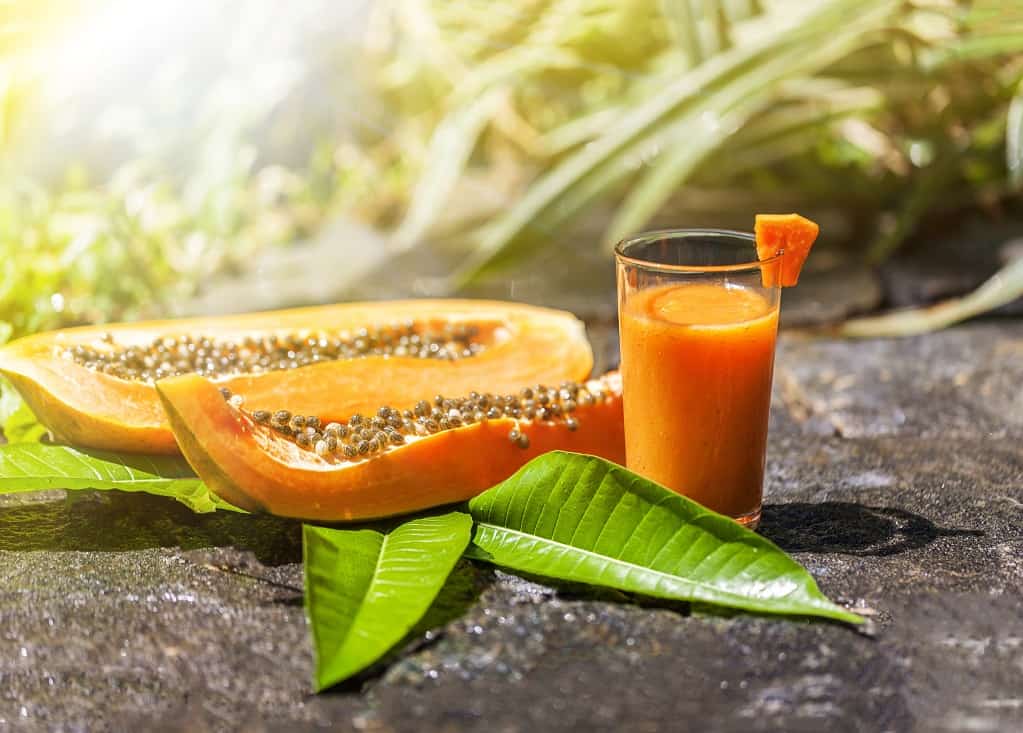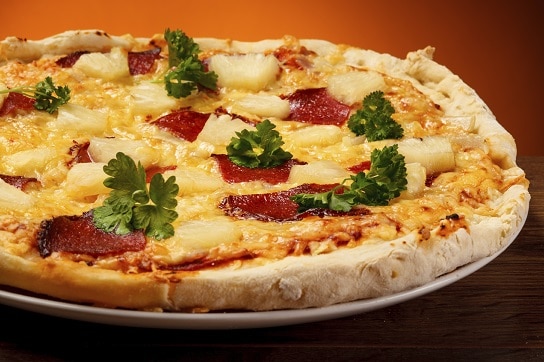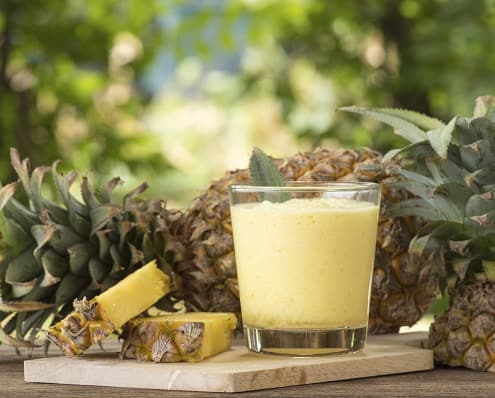Pineapple is the second most popular fruit in the US after the Cavendish banana, and luckily for us, it’s one with many strong acne powers.
Its historical usage dates back centuries, and two of the earliest were as a potent diuretic and labour inducer. By the 1930s and 40s, pineapple was a favourite food of early bodybuilders, who were convinced that it raised testosterone levels, and mixed pineapple’s juice with protein powder to create a tasty pudding.
Interestingly for acne, Native Americans used pineapple flesh in the disinfection of wounds, and many modern people believe that its natural acids stimulate collagen production.
What we’re interested in today, however, is whether the delicious sweet taste of pineapple is safe for acne. I’m happy to report that the pineapple’s only real flaw is its moderate sugar content of 10 grams per 100 grams. I’m also happy to report that the sugar is a complete non-problem anyway if you cunningly organise a low sugar diet elsewhere.
Finally, I’m happy to report that eating pineapple has strong benefits for acne, perhaps even matching strawberries or apples.
Pineapple enhances the absorption of acne nutrients
Pineapple flesh, alongside banana, is the most famous source of the natural enzyme bromelain. This unique compound is used as a meat tenderiser, it can dissolve and weaken stubborn warts, and it’s the main reason why raw pineapple flesh makes your tongue tingle…
…and what unites all of those powers? The strong ability of bromelain to break down proteins and aid their digestion when eaten.
Bromelain is a protease complex first isolated from pineapple back in 1891. Protein enzymes are found in all humans, released by the pancreas into the small intestine to digest any protein consumed.
Read Annihilate Your Acne – get the ultimate diet for clear and glowing skin!
However, your diet also plays a significant role. On one hand, certain foods such as grains and nuts contain unhealthy protease inhibitors, but conversely, there are several common plant foods with natural protease enzymes that perfectly mimic your own.
This power is why bromelain is an ingredient in commercial marinades, why workers in pineapple fields reportedly lose their fingerprints after several years, and why it’s downright impossible to add pineapple to jelly without the gelatin dissolving.
All this is promising for acne in one simple way: by increasing the absorption of nutrients in protein-based foods.
That includes the unskippable mineral zinc, which constrains a hyperactive immune system and is found in meat, oysters and eggs. That includes magnesium, an overlooked acne mineral with multiple talents. That also includes selenium, which occurs in seafood and eggs and is needed to manufacture the acne-clearing master antioxidant glutathione.
Bromelain is found in both the stem and flesh of pineapple. It’s commonly sold as a supplement manufactured in Thailand, the world’s foremost pineapple producer, where the stem is crushed and peeled to extract the raw juice which is then purified.
Bromelain is promising enough that many vitamin companies now include it to maximise their potency, similarly to the piperine alkaloid found in black pepper. Studies have discovered that bromelain makes pharmaceutical drugs such as antibiotics extra effective. Bromelain is found in all four types of pineapple; the sugar loaf, Cayenne, red Spanish and gold pineapples.
Better yet, pineapple contains a second protease enzyme called papain, more famously found in papaya. Papain is also referred to as papaya proteinase, and is the reason why South American natives reportedly ate papaya with meals to aid digestion. According to archeological evidence, papaine may have been used as a meat tenderiser for thousands of years, similarly to bromelain. Papain is also added to some commercial toothpaste brands as a weak tooth whitener.
Whether papaine enhances nutrient absorption isn’t fully studied yet, but combine it with bromelain and you have a seriously promising acne fruit.
Does bromelain reduce red and inflamed acne?
What’s interesting about bromelain is that since 1958, it has been widely available as an unlicensed sports injury supplement in the EU and USA.
The reason? Bromelain is widely believed to calm chronic inflammation, the single most important condition behind acne.
In fact, Germany’s Commission E, the German equivalent of America’s FDA, approved bromelain back in 1993 as a post-surgery anti-inflammatory. Studies on animals show promisingly beneficial results for third degree burns. No studies exist yet on inflammation-induced acne, but for closely related inflammatory conditions, the evidence is ever deepening.
One study, for instance, fed mice either fresh pineapple juice or pineapple which had been boiled to deactivate the beneficial enzymes. After six months, the fresh pineapple mice had survived for far longer. They experienced significantly decreased colon inflammation, both in the short term (within 16 days) and the long term (six months).
The study not only shows that bromelain lowers inflammation, but that pineapple as a whole retains those benefits.
Then there’s the studies examining bromelain specifically; this all-encompassing review concluded that “bromelain… can reduce the average number of days for complete disappearance of pain and postsurgery inflammation“.
Perhaps the most interesting study to date was performed on 146 post-fight boxers with painful bruises to their faces, and haematomas of the obits, ears, lips, chest and arms. 74 boxers were given bromelain 4 times daily during the recovery phase, while 72 boxers were handed an inert placebo.
The difference was stark; 58 of 72 (81%) bromelain boxers enjoyed a complete healing of their bruises within 4 days, with the remaining 16 requiring a further 8-10 days. Only 10 of the control group boxers healed completely, with the rest requiring 7-14 days.
Next, the good Samaritan of bromelain attended to tooth extraction patients. Two groups had their third molar removed and were assigned one of two medicines: either 40mg of bromelain every 6 hours (160mg daily), or 100mg of ketoprofen every 12 hours for 6 days. The latter is an anti-inflammatory pain drug, a pharmaceutical NSAID.
Why bread and pasta are a massive cause of acne
After 6 days, the two remedies reduced inflammation and swelling with equal success. 160mg is also a relatively low dosage, as the optimal for bromelain is believed to be 750-1000mg daily. That’s great news for pineapple, as it means that the real fruit should contain high enough quantities.
There’s great evidence that pineapple lowers chronic inflammation, which should benefit acne tremendously if it reaches your face.
Additionally, many magical acne compounds in foods look promising at first glance, yet fall agonisingly short due to poor absorption rates into the bloodstream. But trusty bromelain breaks those rules – its absorption rate is roughly 40% in the gastrointestinal tract, with absorption peaking roughly 1 hour after consumption. Its half-life in the bloodstream after absorption is equally respectable, with estimates ranging from 1.6-2.5 hours to 6-9 hours.
How does pineapple compare to other fruits?

Pineapple isn’t the lowest fruit in sugar, with a simple to remember 10 grams per 100 grams. That’s lower than grapes (16 grams) or mangoes (14 grams), but higher than strawberries, raspberries and blackberries (all 5 grams), cherries (8 grams) and apricots (9 grams).
Another slight flaw is the pineapple’s relatively low antioxidant count. They score a 456 on the ORAC antioxidant scale, a tiny fraction of the acne-crushing 4302 enjoyed by strawberries, or the 4375 found in apples.
But pineapples then have the advantage of containing very few FODMAPs. This is a group of carbohydrates found in plant foods, which people who didn’t hit the digestive genetic lottery find hard to stomach. They often cause explosive acne outbreaks from seemingly healthy foods, but pineapples are widely prescribed by doctors for low FODMAP diets (unlike apples or watermelons).
The pineapple’s signature power is also relatively unique, because the only other fruit containing bromelain contains just smidgens – the banana. There’s also a power rarely found in fruits: deep sleep enhancement. A study comparing various plant foods found that pineapple, oranges, and bananas all increased blood melatonin content by over 200%. Another study found that pineapple flesh increased urinary melatonin by 260%.
Melatonin is the main sleep hormone in humans, increasing in darkness when blue light is blocked out. Sleep deprivation worsens many of the insidious conditions behind acne, including elevated stress hormones and chronic inflammation.
Even better, an old 1985 study examining serotonin in 80 natural foods found that pineapple was the second greatest source, with its 17.0mcg beating banana (15.0mcg), kiwi fruits (5.8mcg), plums (4.7mcg), and tomatoes (3.2mcg).
Only plantain contained more, with 30.3mcg. Serotonin is both the precursor to melatonin biosynthesis and the “happiness hormone”, a neurotransmitter which soothes stress and hence all the acne associated with it (and makes you happy).
Pineapples rank in the upper echelons for collagen-boosting vitamin C as well, with 79% of the RDI (48mg) per 100 grams.
Strawberries emerge victorious with 97% of the RDI, but pineapple crushes the majority, including apples, and even raspberries, blueberries and blackberries.
Raw honey – a natural secret for wiping out acne bacteria
In fact, when the pineapple fruit was first discovered in 1492 by early European explorers in its native Paraguay, it quickly became a favourite on long-haul wooden ships for protecting against the much-feared scurvy. This sailor’s disease is nothing more than extreme vitamin C deficiency leading to bleeding gums, madness, and eventually death.
The acne patient’s pineapple selection guide
If you want to enjoy the promising acne-clearing powers of pineapples, then firstly, your pineapple must be FRESH.
Tinned pineapple won’t work for acne, pineapple ice cream won’t cut it for acne. You can’t waltz down to the local Italian restaurant and order a ham and pineapple pizza; the pineapple is almost always from a can.
The bromelain is deactivated in cooked and canned pineapple, as shown by the inflammation study above where fresh pineapple was optimal. The best quality pineapples tend to be heavy for their size. Obviously, larger pineapples will have a greater portion of edible flesh, but the size doesn’t usually impact the nutritional quality of that flesh.
Another great aspect of pineapples is that organic ones are totally unnecessary; few inflammatory pesticides can pierce the thick armour. It’s basic, yet true – it’s pure laws of physics. Pineapple is therefore a consistent member of the “clean fifteen” list, ranking as 3rd cleanest in 2015.
Finally, there’s the question of storage. One study found that refrigerating a pineapple at 5 degrees led to a 10% drop in vitamin C, and a 25% drop in carotenoids. This was a greater loss than mango, strawberries and watermelon, all at less than 5% vitamin C loss.
But that drop occurred after 6 whole days of refrigeration. A 10% reduction in that time is barely anything, so don’t instantly discard a pineapple when it gets old and dusty (maybe if there’s cobwebs on it). The same study found that phenolic phytonutrients didn’t drop at all with age.
Why vitamin C is the acne nutrient you cannot ignore
On the other hand, the bromelain enzyme (and perhaps papaine) becomes less active at refrigerated temperatures. Therefore, here’s your ultimate strategy for maximizing the acne nutrition: keep your pineapple in the fridge, but take it out of the fridge a few hours before eating.
Conclusion – pineapple is excellent for acne
If you’re a big fan of pineapple, then great news: it’s easily one of the better acne-clearing fruits.
Pineapples are excellent for vitamin C, anti-inflammatory properties, and unique enhancement of acne nutrient digestion due to bromelain. They’re very different to apples, also a great fruit, but one which has far less vitamin C and specialises in antioxidants. There’s many styles of acne-clearing fruits to try.
The sugar content of pineapple isn’t as staggeringly high as some paleo diet followers believe (tropical fruit bad: don’t fall for this myth) and is completely harmless if you keep your sugar intake controlled outside of fruits.
The final word? I firmly recommend pineapple as a fruit for clearing acne.
NEXT: get the full skin-clearing diet and wave acne goodbye forever
Thanks for reading!




Well I am not convinced that this is true:
“Another great aspect of pineapples is that organic ones are total unnecessary for acne purposes; few pesticides can pierce the thick armour surrounding the flesh. Pineapple is hence a regular member of the “clean fifteen” foods with low and healthy levels of agrochemicals.”
I am from Germany, and we often hear that levels of pesticides are elevated on pineapple. Pesticides can also cause acne.
So suggesting pineapple for acne healing must be organic! Otherwise it could backfired and you may break out from the pesticide cocktail sprayed on the pineapple.
Pineapple is consistently low on the list of fruits contaminated with pesticides, but thanks for the info on the German situation. Maybe the USA authorities were testing Brazilian/Mexican varieties, whereas the German version (likely to be Indian, Filipino or Thai pineapples) used dodgier production methods. Or it could be that your sources are wrong.
Great article. What’s your opinion on bromelian the supplementation for acne ?
I will do more research but eating pineapple itself is probably smartest; if you’re going to supplement with digestive enzymes, it would be smarter to take a wider variety rather than solely bromelain.
Pineapples cause inflammation in my body and break me out. I used to be able to eat them, fresh. Unfortunately, I’m a case that prooves pineapple consumption doesn’t help everyone’s acne situation.